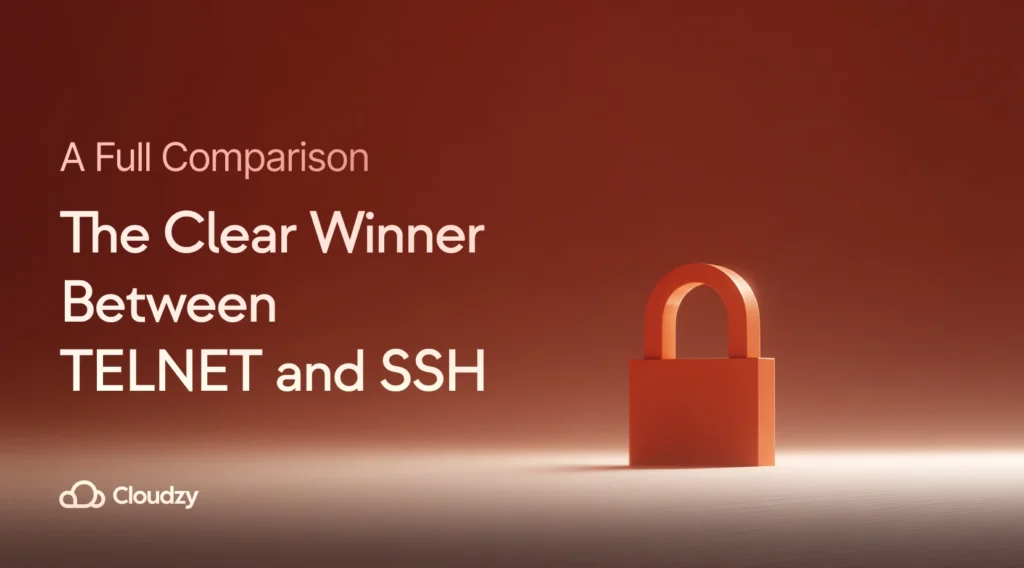In the early days of networking, the common tool for remote access was TELNET. TELNET provided very basic functionality but had a major flaw: everything, including usernames and passwords, was transmitted in plain text. Which is a significant risk. This was when SSH (Secure Shell) came into play.
Comparing TELNET vs SSH isn’t just a comparison of two different protocols. It’s a matter of necessity. SSH works by encrypting everything that is sent between the client and server, preventing other networked individuals from intercepting, intruding, or accessing that information. TELNET had everything sent in plain text, which allows everyone listening in on the network to gain access to that communication.
Today, we will take a look at SSH vs. TELNET, examine the differences, and discuss why SSH has become the clear choice for secure remote communication in today’s environments.

TELNET
What is TELNET?
The word “TELNET” stands for TELecommunication NETwork. and is practically as old as the Internet. TELNET is the standard TCP/IP protocol designed for virtual terminal services. Using TELNET allows you to establish a connection to a remote system in a way that appears like a local system. In other words, TELNET is a network protocol that enables virtual access to a computer and provides a two-way, collaborative, and text-based communication channel between two systems. For full protocol details, you can refer to the RFC 854 Telnet Protocol Specification.
Advantages and Disadvantages of Using TELNET
In what follows, I’ve listed some benefits and drawbacks of TELNET.
Advantages of TELNET
- Terminal access over TCP
- Standard NVT interface
- Cross-platform support
- Remote host access
- Protocol-agnostic, platform-independent
Disadvantages of TELNET
- Unencrypted, character-based
- no GUI or cursor support
- Poses inherent security risks
As we stated in this section, using TELNET can cause many flaws, which is why Secure Shell emerged in the mid-1990s to guarantee safety and security
When to Use TELNET
TELNET is a relic. It’s simple and fast. Still, there are a few specific cases where using TELNET makes sense. We will discuss more in the TELNET vs SSH comparison table.
1. Quick Network Testing
If you just need to check whether a port is open or a service is responding, TELNET can be a quick and easy diagnostic tool.
2. Working with Older Equipment
Some older routers, switches, or embedded systems still only support TELNET.
3. Closed Environments
In lab setups, test networks, or other isolated environments where security isn’t a concern.
Outside those narrow use cases, though, TELNET is best left in the past. For anything that touches production systems or public networks, SSH is the modern, secure standard. It gives you the same functionality with encryption, authentication, and peace of mind built in.
SSH (Secure Shell)
What is SSH?
SSH (Secure Shell), also known as Secure Socket Shell, is a network protocol that offers users, especially system administrators, a secure way to access a computer over an unsecured network.
Not only does SSH provide strong password and public key authentication, but it also gives you encrypted data communications between two computers connecting over an open network. The official specification is detailed in RFC 4251: SSH Protocol Architecture.
In simple terms, the SSH protocol can encrypt traffic in both directions, helping you to prevent trafficking, sniffing, password theft, and other complications.
In addition, network administrators can widely use SSH to manage different systems and applications remotely. This feature of SSH enables network administrators to log in to another computer over a network, execute commands, and move files between computers.
Now that you are familiar with these protocols, we can discuss the purpose of this article (TELNET vs SSH comparison) in the following section.
Advantages and Disadvantages of Using SSH
Of course, SSH is more secure than TELNET; However, SSH has its cons.
Advantages of SSH:
- SSH allows data encryption so that hackers and attackers cannot access user information and passwords
- SSH also permits tunneling of other protocols, though some, like FTP, may require additional configuration
- SSH supports multiple authentication methods, including passwords, public/private key pairs, and even multi-factor authentication
- Protocols like SCP (Secure Copy Protocol) and SFTP (SSH File Transfer Protocol) run over SSH, providing file transfer capabilities
- Remote command execution and scripting, which makes it ideal for automation, configuration management, and DevOps workflows
Disadvantages of SSH:
- SSH requires a bit more configuration than TELNET
- Because SSH encrypts and decrypts all traffic, it introduces a small amount of processing overhead
- In large environments, maintaining and rotating SSH keys securely can become a major administrative task
- By default, SSH doesn’t provide deep session monitoring. Without proper logging or auditing tools, tracking user activity or detecting unauthorized access can be difficult
- Because SSH gives powerful remote access, a compromised account can cause potential for abuse.
When to Use SSH
SSH is the default choice for secure remote access in nearly every modern environment.
- Remote Server Management: Whenever you need to access a remote machine.
- Secure File Transfers: When moving files between systems, use SSH-based tools like SCP or SFTP. They make sure everything stays encrypted
- Automated Administration: For DevOps, system administration, and automation tools, SSH is the backbone
- Environments with Sensitive Data: Any situation where confidentiality, data integrity, and authentication matter should default to SSH, especially in finance, healthcare, and enterprise IT
For a full graphical experience, upgrade to an RDP from Cloudzy. Enjoy 40 Gbps network speed, ultra-low latency, and built-in DDoS protection that keep your sessions stable and responsive.
Cloudzy RDP delivers a secure, high-performance environment that feels fast and natural. Move beyond text-only connections and take your workflow to the next level with a powerful graphical interface.
Overview of the Difference Between SSH and TELNET
Even though TELNET and SSH have some similarities, there are many differences between these protocols, which can separate them. The most significant dissimilarity between the two is that SSH is more secure than TELNET. For this reason, we can say that SSH has replaced TELNET in almost every service. Having this in mind, let’s discuss the TELNET vs SSH comparison in more detail. TELNET or SSH, that is the question.
| Point of View | SSH | TELNET |
| Authentication | Strong, passwords, keys, MFA | Weak, usually passwords only |
| Security | High, encrypted, secure | None, plain text, vulnerable |
| File transfer | Yes, SCP, SFTP built-in | No, requires extra tools |
| Protocol | Secure Shell (SSH) | TELNET protocol |
| Usage | Secure remote access, admin, automation | Legacy remote access |
| Data encryption | Yes, strong encryption | No, plain text |
| Default port | 22/tcp (IANA) | 23/tcp (IANA) |
| Data formats | Binary, encrypted text | Plain text |
| Operating systems | Cross-platform, modern support | Cross-platform, legacy focus |
| Bandwidth usage | Slightly higher, encryption overhead | Low, no encryption |

Conclusion
SSH and TELNET are both network protocols that can help you access and manage devices remotely. While TELNET is basic, text-based remote access, it is unencrypted and does not provide modern security.
SSH is encrypted, offers multiple authentication options, and secure file transfer, and represents the standard for current network management processes. In nearly all production environments, SSH is the logical, practical, and real-world choice.


![Use SSH to Connect to a Remote Server in linux How To Use SSH to Connect to a Remote Server in Linux?[2023 Edition]](https://cloudzy.com/wp-content/uploads/Use-SSH-to-Connect-to-a-Remote-Server-in-linux-420x234.png)


